Picture this: it's time to fix dinner, and your family is craving a crispy batch of homemade French fries. You fill your pot with whatever oil you grab first from the pantry. Then, you fry your way through the first batch of potatoes – and your house fills with smoke.
I don't know about you, but it's happened to me more times than I'd like to admit (picture my wife and kids waving a towel at the detector).
Not every cooking oil is created equally. Some oils are ideal for frying, while others are better for baking or grilling. Some oils aren't even suitable for cooking at all!
In this guide to cooking oils, I'll lay out everything I know (and have researched). Avoid the mistakes of younger Gerard – and enjoy the read!
Cooking oils are fats used in baking, frying, and cooking food.
With cooking, oils help to distribute heat. In baking, oils and fats add moisture. Fats also react with sugar to help with the leavening process. Certain types of oils can even impart extra flavor, for example, the oils used in salad dressings.
Each type of oil has different physical properties that make it suitable for different types of cooking. Knowing which type of oil is best for each cooking technique is excellent knowledge that will level up your culinary skills.
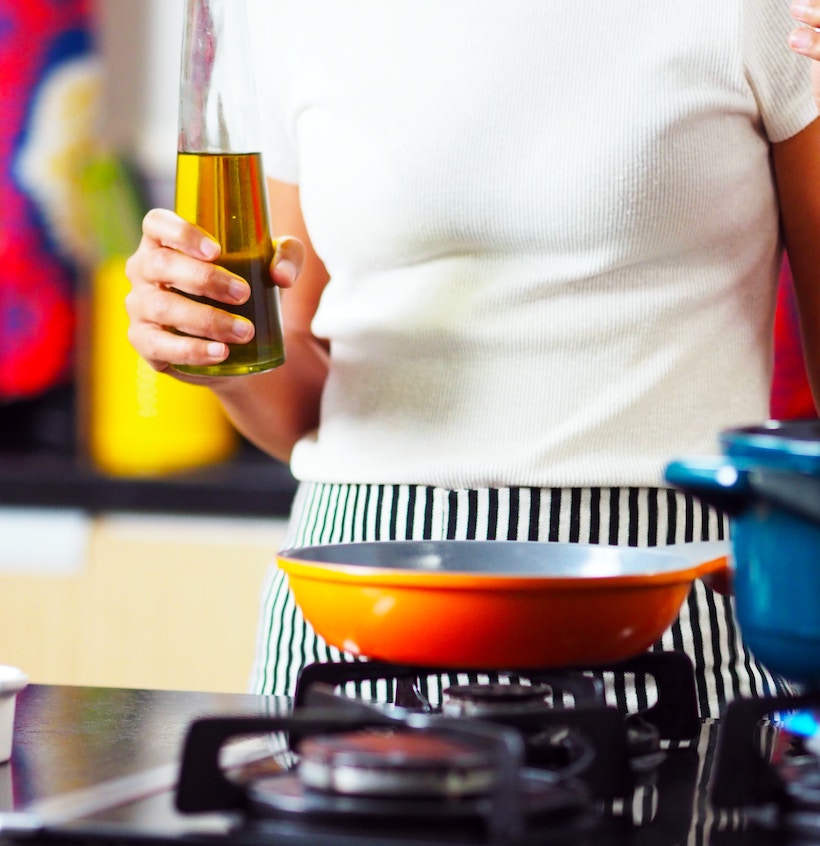
Cooking oils are composed of different fatty acids.
Some of the different fats we see in cooking oils include unsaturated fats, saturated fats, and essential fatty acids.
As you'd expect, it's complicated – different types of oils have entirely different chemical compositions. These compositions affect how a particular oil reacts to heat, which is the main reason why certain oils are best for deep-frying and others for pan-frying – while others are best at room temperature.
Stability refers to how well an oil can withstand exposure to heat, oxygen, or light before it becomes burnt or rancid.
In general, oils high in saturated fats tend to be the most stable. A cooking oil with greater stability can withstand high temperatures for more extended periods and have a relatively long shelf life.
The smoke point of an oil is the temperature the oil needs to reach to begin producing smoke.
Generally, when you see smoke, it means the oil has begun to burn. Burnt oil imparts an unmistakable burnt odor and flavor to any food that's cooked in it. Techniques that use a lot of high heat, such as deep-frying and roasting, will need oil with a higher smoke point.
Whether it comes from olives or avocados, there are three main ways to extract oil from its source.
A lot of commercially-produced cooking oils will use a combination of the following methods to produce the oil you buy at the store:

Oils are a form of fat, just like the fat found in food.
When we break down fats even further, we see that they're made of different types of fatty acids. The various fatty acids can be considered good, bad, or neutral, depending on how they affect the body.
Saturated fats have no carbon double bonds in their chemical makeup.
For us layfolk, all we have to remember is that most of the saturated fats in our diets come from animals. Also, saturated fats are usually solid at room temperature. Lard, butter, and beef tallow are some common examples of saturated fats.
In the recent past, saturated fats were considered "bad" fat. It turns out we didn't quite have the full story.
Previously, saturated fat was observed to raise bad cholesterol - specifically, LDL or low-density lipoprotein cholesterol. Because of that link to unfavorable cholesterol ratios, saturated fat was thus assumed to cause heart disease.
However, multiple research studies show that there is no direct link between saturated fat and heart disease. Further, more studies have cast doubt on LDL deserving its entirely negative reputation.
Therefore, saturated fat probably isn't a bad fat, per se. It may be the case that different types of LDL are worse than others, or there is some ratio of LDL types or interaction with HDL that is wrong. For now, be cautious – and note the American Heart Association still recommends you limit your saturated fat intake to no more than 5-6% of your fat intake per day.
Until you hear further, enjoy those saturated fats in moderation. Yes, I know – they are delicious, though.
Monounsaturated fat molecules have one carbon double bond, and we might call it a "good" fat.
Studies show that consuming moderate amounts of monounsaturated fats can help lower bad (LDL) cholesterol and prevent diseases such as stroke or heart disease. Food sources of monounsaturated fats include avocados, nuts, peanut butter, and olives.
Oils from those sources are also high in monounsaturated fat, as you'll see in my roundup.
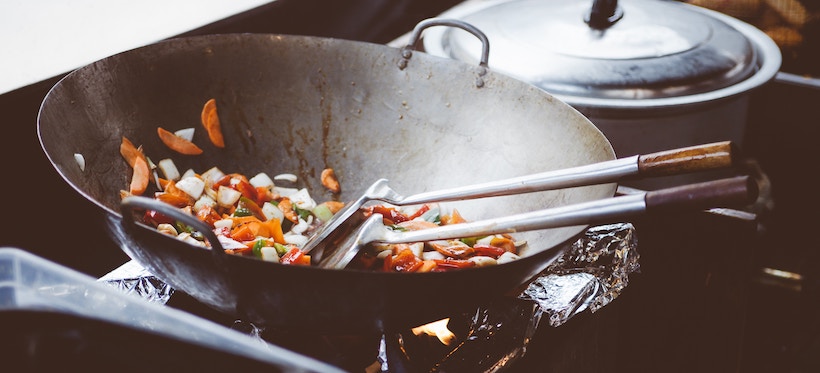
Polyunsaturated fats have two or more carbon double bonds. This type of fat can also help lower bad (LDL) cholesterol. Some examples of food high in polyunsaturated fats include salmon, seaweed, oysters, nuts, and tuna.
Polyunsaturated fats also include some essential fatty acids.
The human body can't produce essential fatty acids, which are mandatory for brain function and metabolic support. Therefore, we have to rely on our diets for intake. There are two main types: omega-3 and omega-6 fatty acids. Currently, scientists believe that alpha-Linolenic acid is essential on the omega-3 side and Linoleic acid on the omega-6 side.
Many sources of omega-3 and omega-6 fats might also contain omega-9 fatty acids. Monounsaturated omega-9 fatty acids are considered nonessential – the human body can synthesize them on its own.
Trans fats are widely considered the very worst type of fat, thanks to their uncanny ability to raise bad cholesterol while lowering good cholesterol at the same time. Most of the trans fats in our diets used to come from partially-hydrogenated oils, which give food products a longer shelf life.
Packaged snacks, pre-made frosting and refrigerated dough, margarine, and non-dairy creamer are some everyday products that used to contain partially-hydrogenated oils and were significant sources of trans fat.
In 2015, the U.S. Food & Drug Association moved to ban artificial trans fats (specifically Partially Hydrogenated Oils) from the food supply. In 2018 that ban went into effect – most PHOs are effectively banned from food products in the U.S.
There are some naturally curring trans fats in foods – interestingly, ruminants are a source. However, in the U.S. and many other countries, PHOs are now banned from processed food.
The length of their carbon chains can also classify fats. Commonly, we divide fats into long, medium, and short-chain fatty acids.
(Actually, there is a very long chain too – greater than 21 carbon atoms in length – but it's uncommon).
Interestingly, SCFAs and MCFAs in the form of Medium Chain Triglycerides are primarily absorbed through the portal vein, while longer chain fatty acids are absorbed indirectly and eventually through the subclavian vein.
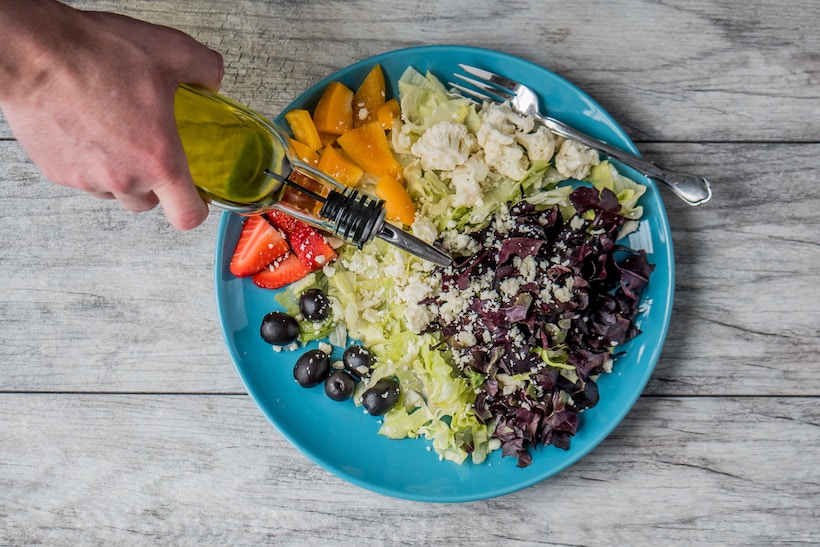
Regardless of whether it's good fat or bad fat, cooking oil is still fat.
At nine calories per gram, oil has over twice the caloric density as carbohydrates or protein. One tablespoon of oil can have over 13 grams of fat (close to 120 calories), so the calories can add up very quickly. We all need fat in our diets, but too much can be unhealthy – and even deadly.
Therefore, it's best to use oil sparingly as part of a balanced diet, even if you're loading up on the good fats.
Linoleic acid is a type of omega-6 fatty acid that can lower bad cholesterol, especially when it replaces saturated fats in the diet. It's also an essential fatty acid – but generally, most people get it in sufficient quantities from diet.
Many vegetable oils, such as corn, soybean, and safflower, are rich in linoleic acid.
Some studies suggest a link between consuming too much of the omega-6 fatty acid and chronic inflammatory diseases, which includes diabetes and arthritis.
While more research on this topic is undoubtedly warranted, experts recommend replacing oils high in omega-6s whenever possible. Canola, corn, and soybean oil (and oils generally marked "vegetable oil") are examples of cooking oils with high levels of omega-6.
Olive and coconut oil are two alternatives with lower omega-6 content.
Free radicals are harmful compounds that can form when an oil is heated past its smoke point. Ingesting these compounds can damage cellular DNA, and their effects include everything from premature aging to cancer.
Using a cooking oil with a high smoke point will reduce the chances of free radical formation – it just takes more heat before the oil breaks down. Understanding smoke points is essential when picking out oils for high-heat cooking.
Cooking oils can be a good source of omega-3 and omega-6 acids, which are vital for our health. At the same time, too much omega-6 in proportion to omega-3 can contribute to chronic inflammation – and the dreaded metabolic syndrome. Unfortunately, nowadays, we're inundated with unbalanced ratios of omega 6s to 3s – and partially as a result, our average BMI has been creeping up.
The best way to enjoy oil is in a well-rounded diet – get your vital nutrients from many different sources and be sure to mix in omega-3 sources. In short, oil can be healthy, but you need to be careful to use it in moderation – and not heat your oils beyond the point where they break down.
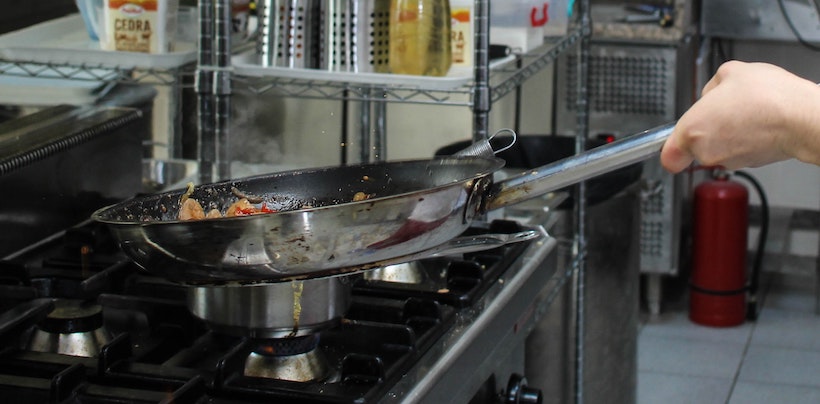
Now, it's time for the fat of the post (puns are always intended).
I'm going to cover a number of cooking oils and give a brief overview of how they are made. If there are some special storage considerations, I'll try and cover that too.
For each oil, I've also gathered information on its smoke point, its proportion of monounsaturated, polyunsaturated, and saturated fats, and also it's omega-3 and omega-6 contents per tablespoon.
Avocado oil is pressed from the edible pulp of the avocado.
It's high in monounsaturated fat and extremely stable. With a smoke point as high as 520 °F, you can use this oil for deep-frying, shallow-frying, grilling, roasting, etc. – really, any cooking you can imagine. At the same time, its mildly nutty flavor can make it an excellent component in a salad dressing.
Although this oil is highly stable, store it only in a cool, dark place after opening.
Per tablespoon
Butter is a dairy product that's usually solid at room temperature.
Its creamy texture and soft, neutral flavor makes it ideal for baking or for making sauces. As a cooking medium, butter has a relatively low smoke point, so it should only be used for light frying at most. But don't worry – if you like butter, ghee is a suitable alternative at higher temperatures.
Exposure to air, light, and high temperatures can cause it to spoil, so it's best to store butter in a sealed container in the refrigerator.
Per tablespoon
Ghee is a type of clarified butter originating from India.
Clarified butter is the product that's leftover after water and milk solids are rendered from regular butter. When clarified butter is boiled to cook any remaining milk solids, the final product is called ghee.
Ghee is, of course, great for cooking traditional Indian dishes, but is also an excellent general-purpose cooking oil. With a much higher smoke point than butter, it's also a suitable frying oil.
Per tablespoon
Canola oil comes from the canola seed, which is a subspecies of rapeseed.
Canola oil is very low in saturated fat and high in monounsaturated fat, factors which have been theorized to help lower the risk of heart disease. Of course, it is high in omega-6 fats, which, when unbalanced, can cause inflammation. You should note, though, that a couple studies point to the possibility canola oil is bad for heart health and obesity.
Because it is relatively stable, has a high smoke point, and tastes almost like nothing, it's one of the most versatile cooking oils available. If you aren't concerned about the potential downsides, use it for anything from deep-frying to salad dressing.
Per tablespoon
Coconut oil comes from mature coconut meat and is 99% fat, most of which is saturated fat.
Its saturated fat content keeps coconut oil pretty stable, but note the AHA recommends you limit saturated fats like coconut oil in high quantities. Thanks to the sweetness of the fruit, coconut oil's flavor combines well with baked desserts.
Being mindful of its boiling point, it can also make an excellent moderate-heat cooking oil. Note that unrefined coconut oil has a lower smoke point than refined.
Per tablespoon
*- Refined
**- Unrefined
Derived from the germ of maize, corn oil is one of the most common and least expensive cooking oils.
Its high smoke point makes it a popular choice for deep-frying. It's also very high in omega-6 fatty acids.
Per tablespoon
Flax oil, also known as linseed oil, comes from the seeds of flax plants.
Due to its low smoke point, it's not recommended for actual cooking. In certain parts of Europe, flax oil is used to add nuttiness to dishes that have already been cooked. In the U.S., flax oil is most often seen as a nutritional supplement, thanks to its high omega-3 content in relation to omega-6.
Per tablespoon
As the name implies, grapeseed oil comes from the seeds of grapes, which are often sourced from grapes left over from winemaking.
Surprisingly, most people find grapeseed oil doesn't taste like grapes at all and is, in fact, quite neutral in flavor. That, combined with its high smoke point, makes it highly versatile as a cooking oil.
Grapeseed oil is used for cooking, baking, and whisking vinaigrettes. It's not as shelf-stable as other cooking oils, so it's best to keep away from light and heat. Inside a dark glass bottle inside your refrigerator is the ideal place to store your grapeseed oil.
Per tablespoon
Hemp oil is most familiar to us as the moisturizing agent in hemp-based soaps, lip balms, and lotions. However, it also has some uses in the kitchen.
Most commercially-available hemp oil is unrefined, meaning it can be more susceptible to combustion. Coupled with a low smoke point, that makes hemp oil terrible for cooking. However, its flavor has been likened to walnuts or sunflower seeds, so it makes an excellent dipping or dressing oil.
Adding a drizzle of hemp oil on top of rice, pizza, or a salad can add a bit of flavor along with some beneficial fats.
Per tablespoon
*- The exact amounts of omega-3 and omega-6 fatty acids per tablespoon of hemp oil are yet to be determined, but the ratio of omega-6:omega-3 in hemp oil is between 2:1 and 3:1.
Lard is the rendered fat from pork and, therefore, a byproduct of the pork industry.
As a cooking oil, it can add a nice, meaty flavor to savory dishes and heats well without burning. It was popular all over the world until vegetable oils rose to prominence. Today, lard is most commonly used in traditional French or European cooking. It also has no or very low trans fats.
To store lard, keep it in a sealed container in the refrigerator.
Per tablespoon
Tallow is rendered fat from beef or mutton.
It was a standard frying oil in fast-food restaurants until vegetable oils became more popular. Today, tallow isn't nearly as popular as lard as a cooking oil. These days, it's often used as a dog food ingredient – although it has been picking up some in popularity as people rediscover its excellent properties.
Per tablespoon
Margarine has gone through a lot of transformations since it was first invented in Napoleonic times. Today, it refers to a "non-dairy spread" derived from refined vegetable oil and water.
Margarine is a suitable replacement for butter among people who can't process lactose or feel the need to decrease their saturated fat intake. Much like butter, margarine is great for baking and moderate cooking, but not deep-frying.
Per tablespoon
Virgin olive oil is an oil that's been cold-pressed from olives without any additional processing.
This grade of olive oil has the most flavor, which can be either peppery, nutty, or sweet. It's best for dipping bread or dressing salads.
Extra virgin olive oil can also be used for cooking, light frying, and baking.
Per tablespoon
Refined olive oil comes from virgin olive oil that has been processed further.
The refining process can involve filtering, introducing chemical solvents, or both. The purpose of refining olive oil is to increase its stability. It doesn't have the flavor or fragrance of virgin olive oil, so it doesn't make a very pleasing tasting oil.
Refined olive oil works best as a healthier alternative to many frying oils.
Per tablespoon
Palm oil is pressed from the fruit and seeds of certain species of palm trees. In cooking, it's mostly used as a substitute for butter or shortening.
With its high saturated fat content, palm oil remains solid at room temperature, so it works well in baked pastries and doughs. Palm oil has no trans fat, so it has recently gained popularity as a "healthy" alternative to other cooking oils.
Per tablespoon
Peanut oil is a relatively stable oil with a high smoke point, making it appropriate for everything from sautéeing to deep-frying.
It tends to have a strong peanutty taste, and it complements many Asian cuisines well.
Peanut oil is pretty long-lasting. As long as it's sealed in a dark place, peanut oil can stay fresh for several months.
Per tablespoon
Sourced from safflower seeds, safflower oil is one of the newest, "healthier" alternatives for cooking oil. It's packed with good fats and relatively low in bad fats.
Safflower oil tends to come in two varieties:
Per tablespoon
Sesame oil is an interesting oil – it's useful both as a cooking oil and a flavoring agent. It's one of the world's oldest crop-based oils, and it's most often seen in Korean, Chinese, and South Indian cuisines.
Light, refined sesame oil, which is usually a pale yellow, can be used in frying and grilling. Dark sesame oil, derived from toasted seeds, has a lower smoke point and is more suitable for flavoring.
Per tablespoon
Soybean oil is produced from the soybean plant, and it's one of the most versatile cooking oils available.
With a high smoke point, neutral flavor, and virtually nonexistent odor, it's widely regarded as an effective frying oil. Soybean oil contains a high amount of omega-3 fatty acids and polyunsaturated fats, which can help lower LDL if it replaces saturated fat in the diet.
Per tablespoon
Sunflower oil comes from sunflower seeds.
It's particularly prone to rancidity and oxidation, so it must be refrigerated to prevent spoilage. As you can see, it's very high in mono- and polyunsaturated fats, which are the so-called good fats.
It's extremely popular for general cooking and deep-frying. Lately, it's gained popularity as a healthy frying oil for commercially produced potato chips.
Per tablespoon
While walnut oil has a mild flavor and moderate smoke point, many chefs don't opt to use it for cooking because of its steep price.
Walnut oil has a delicate, aromatic taste, which can be altered by heat. So, while it's possible to use walnut oil for some light cooking, it's better to use it for finishing cooked dishes and dressing salads.
Walnut oil is also prone to rancidity. As long as it's refrigerated, it should keep for 6-12 months.
Per tablespoon
Technically, any edible oil from the fruit or seed of a plant can be called "vegetable oil."
The bottles of vegetable oil found at the supermarket are usually blends of different types of oil, manufactured with the goal of shelf-stability, versatility, and price point in mind. Corn, soybean, and canola are only some of the oils that might be found in a bottle of vegetable oil.
Because of this, different brands of vegetable oil might vary as far as their nutritional benefits go – but they're generally not the best nutritionally. However, they are also one of the most versatile and inexpensive cooking oils.
Per tablespoon
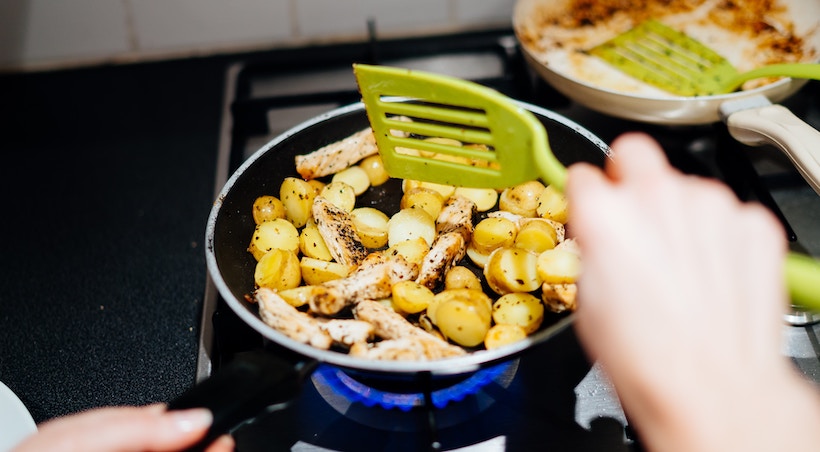
Oils for generic cooking should be light with a mild or neutral flavor and have a high smoke point.
Look for a smoke point above 350 F°. Canola, corn, and coconut oil are common examples with smoke points in the ideal range.
(Note that unrefined coconut oil has a smoke point near 350 degrees Fahrenheit, while refined coconut oil puts you closer to 400.)
Oils for deep-frying should be high in saturated fats with a smoke point above 400 °F. They should also be neutral in flavor.
Lard, peanut oil, and ghee are some easy-to-find examples of oils that are safe for deep-frying.
In the chemical art of baking, oil provides the fat component of a recipe. Since all oils are fats, you can choose any oil in your pantry to keep cakes and pastries fluffy – note that it'll impart its own characteristics on your dish.
All that in mind, the flavor of the oil must harmonize with the other ingredients of the recipe. This is why neutrally-flavored oils like vegetable oil, canola oil, and butter are the usual fat sources seen in baking recipes.
Far beyond just saving you and your family and friends from waving towels at smoke detectors, picking the best oil is an art and a science. Hopefully, this cooking oil guide conveyed the information you need for the next time you step into the kitchen to whip up a dish.
I wish I had known all of these things when I first started cooking in earnest. Let me know how it worked for you – Bon Appétit!